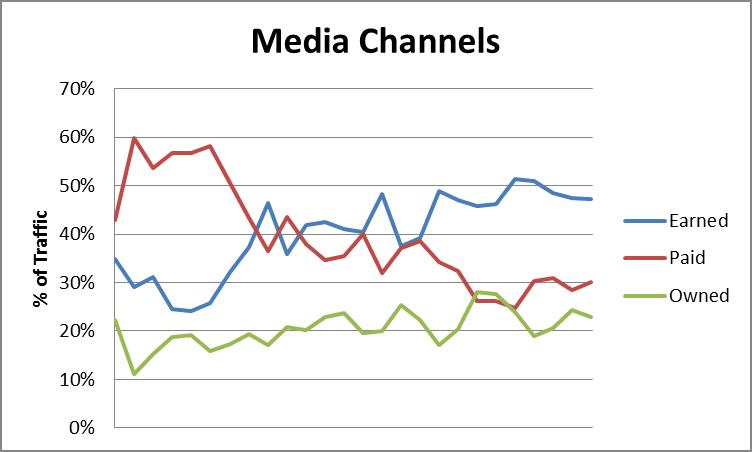The Difference Between Paid and Earned Media (And Why It Matters)
Table of Contents
Getting your brand noticed in today’s crowded digital landscape requires a strategic approach to media. Understanding the fundamental distinction between paid vs earned media is crucial for any business looking to maximize its visibility and impact.
Paid media involves directly purchasing advertising space or sponsored content. It gives you control over messaging and placement but requires a financial investment.
Earned media represents the organic coverage and mentions your brand receives without direct payment. Think press features, social shares, and word-of-mouth recommendations.
Your communications strategy depends heavily on balancing different media placements, significantly impacting your budget and results. Many businesses struggle to find this balance, often overinvesting in one over the other.
This inefficiency isn’t uncommon. The assumption has remained unchanged from early advertising reviews to more recent research. Most companies are just not spending on media optimally.
When properly understood, the unique advantages, limitations, and appropriate applications of paid and earned media save resources and shape a more effective PR approach that builds visibility and credibility for your brand.

Source: HuffPost
What Is Paid Media?
Paid media encompasses any form of advertising or content promotion that requires financial investment to secure placement and visibility. Unlike organic approaches, paid media gives you direct control over where, when, and to whom your message appears.
In the ongoing paid vs earned media discussion, paid media stands out for its immediacy and precision.
Common Types of Paid Media
Before diving into specific formats, it’s essential to recognize the diverse range of paid media channels available to marketers today. Each type offers unique advantages depending on your goals, audience, and budget constraints.
- Sponsored Content: This includes articles, videos, or posts created to mimic the style of a publication while promoting your brand.
- Advertorials: These blend editorial content with advertising, appearing as regular articles but containing promotional messaging.
- Paid Features: These dedicated pieces highlight your brand or product in established publications. Securing a Forbes feature can significantly boost credibility, given the publication’s authority in business circles.
- Social Media Advertising: Platforms like Facebook, Instagram, and LinkedIn offer sophisticated targeting options to reach specific demographics based on interests, behaviors, and other parameters.
- Search Engine Marketing: Pay-per-click campaigns on search engines help your brand appear at the top of search results for relevant keywords.
Advantages of Paid Media
The benefits of paid media attract brands seeking predictable, measurable results. These advantages explain why paid media continues to be a cornerstone of most marketing strategies:
- Immediate Visibility: Paid media delivers instant exposure once your campaign launches.
- Precise Targeting: Advanced targeting capabilities allow you to reach specific demographics, interests, and behaviors.
- Control Over Messaging: You maintain complete control over your content, timing, and placement, ensuring brand consistency across all touchpoints.
- Flexibility: Campaigns can be adjusted in real-time based on performance data, allowing for continuous improvement and budget optimization.
Disadvantages of Paid Media
Despite its many benefits, paid media has several challenges that marketers must navigate carefully:
- Cost Considerations: Paid media requires ongoing financial investment, and costs can escalate in competitive markets.
- Ad Fatigue: Audiences may become desensitized to paid content over time, leading to diminishing returns and requiring frequent creative refreshes.
- Trust Challenges: Consumers often perceive paid content as less trustworthy than earned media or organic recommendations, potentially affecting credibility.
- Ad Blocking: The increasing use of ad-blocking technology can limit the reach of your paid campaigns, especially among tech-savvy audiences.
- Temporary Impact: Once you stop investing in paid media, visibility typically disappears, unlike earned media, which can continue generating results over time.
The paid vs earned media balance will vary depending on your goals and resources. For instance, a publication like Forbes has hundreds of millions of monthly visitors worldwide, making it a powerful paid media channel for reaching global business audiences.
Elevate Your Brand’s Exposure with a Smart Media Mix
Ready to increase your reach and credibility? Partner with Spynn and let us guide you to the perfect media balance for your business growth.
What Is Earned Media?
Earned media refers to exposure gained through non-paid means, such as word-of-mouth, social media sharing, news coverage, or online mentions. Unlike paid media, which requires direct financial investment, earned media is generated organically.
In the paid vs earned media debate, earned media represents authentic conversations about your brand rather than the messages you control through advertising.
Common Types of Earned Media
The digital ecosystem offers numerous opportunities for your brand to generate valuable earned media:
- Media Coverage: When journalists or media outlets feature your company in news articles without payment.
- Social Media Mentions: Instances where individuals, influencers, or organizations discuss or promote your brand or content on platforms like Twitter, Facebook, or Instagram without sponsorship.
- Customer Reviews: Positive reviews or recommendations from customers, industry experts, or bloggers generate significant earned media value.
- Word-of-Mouth Recommendations: Traditional person-to-person recommendations remain powerful forms of earned media, even if they don’t produce tangible content. These conversations drive trust and consideration among potential customers.
Advantages of Earned Media
The continuing debate on paid vs earned media shows earned media offers several benefits that make it an essential component of any comprehensive marketing strategy. These are some of the benefits:
- Enhanced Credibility: Earned media typically carries higher levels of trust and credibility than paid media because it’s perceived as an independent, trusted source endorsement.
- Cost-Effectiveness: Earned media is generally free or low-cost compared to paid advertising campaigns.
- Broader Reach: Earned media, such as word-of-mouth and social sharing, can exponentially expand your audience beyond what your owned channels might achieve independently.
- Organic Growth: Because earned media is generated by customers, fans, and external sources rather than paid promotion, it drives authentic brand engagement.
Disadvantages of Earned Media
Earned media may offer significant benefits in the paid vs earned media equation, but it also presents challenges:
- Limited Control: With earned media, you have minimal control over the message, timing, and placement, which don’t always align with your brand strategy.
- Measurement Difficulties: Earned media can be challenging to track and measure accurately, making it difficult to quantify its precise impact on ROI.
- Unpredictability: The nature of earned media makes it challenging to generate consistently or on demand, as it depends mainly on the actions and opinions of others. This unpredictability can create gaps in your media presence.
- Potential for Negative Coverage: Not all earned media is positive. Negative reviews, criticism, or unfavorable coverage can spread like wildfire, potentially damaging your brand reputation.
Understanding the nuanced relationship between paid vs earned media helps you develop a more balanced, practical marketing approach. While paid media offers control and predictability, earned media provides authenticity that advertising cannot replicate.
The most successful brands don’t choose one over the other; they strategically integrate both to maximize their strengths.

Paid vs Earned Media: Key Differences
Understanding the fundamental difference between paid and earned media helps you strategically decide where to invest your marketing resources. While both approaches can build brand awareness, they operate on different principles and deliver distinct benefits.
The paid vs earned media comparison encompasses several critical dimensions that impact how you might strategically combine both:
Paid Media
- Control and Messaging: Complete control over content, timing, placement, and targeting.
- Speed and Predictability: Immediate, predictable visibility once your campaign launches.
- Credibility and Trust: Generally perceived as less trustworthy due to its commercial nature.
- Cost Structure: Direct financial investment that scales with exposure.
- Measurement and Analytics: Precise metrics on impressions, clicks, conversions, and ROI.
Earned Media
- Control and Messaging: Limited control as journalists, customers, and influencers shape the narrative based on their perspectives.
- Speed and Predictability: Unpredictable timelines dependent on media cycles and editorial decisions.
- Credibility and Trust: Higher trust and credibility through third-party validation.
- Cost Structure: Time and resource investment rather than direct payment. Digital PR agencies often manage these efforts.
- Measurement and Analytics: Less straightforward measurement requiring specialized monitoring tools.
Many digital PR agencies specialize in helping brands navigate this complex landscape, developing integrated strategies that leverage both approaches. The most effective campaigns don’t treat paid and earned as separate silos but rather as complementary tools within a unified communications strategy.
Benefits of Combining Paid and Earned Media
Rather than viewing paid vs earned media as competing approaches, the most successful brands recognize the synergy created by integrating both strategies. A balanced approach leverages the unique strengths of each channel while offsetting each channel’s limitations.
When strategically combined, paid and earned media deliver stronger results than either approach alone:
- Enhanced Credibility: Paid campaigns featuring earned media mentions gain increased trustworthiness and authority
- Extended Reach: Paid promotion amplifies earned media coverage, reaching larger audiences than organic distribution alone
- Improved Conversion Rates: The combination of controlled messaging (paid) and third-party validation (earned) creates more compelling customer journeys
- Consistent Visibility: Paid media fills gaps between earned media opportunities, maintaining steady brand presence
- Stronger Content Performance: Paid amplification helps valuable content gain initial traction, potentially triggering earned media coverage
- More Efficient Budget Allocation: Insights from each channel inform and optimize the other, maximizing overall marketing ROI
Developing an effective earned media strategy requires patience and relationship-building, but the resulting third-party validation creates authentic connections with your audience that paid advertising alone cannot achieve.
This explains why marketers allocate their digital marketing budgets equally between these complementary approaches. A recent survey shows that marketers allot approximately 24% of the budget to earned media and 25% to paid media.
Unlock the Power of Paid Media for Maximum Exposure
Boost your brand’s visibility and build lasting trust by leveraging Spynn’s proven media expertise. Start your journey to smarter exposure now!
How Spynn.co Helps You Navigate Paid and Earned Media
Finding the right balance in your paid vs earned media strategy can be challenging without expert guidance. Spynn.co specializes in helping businesses develop comprehensive media approaches that maximize visibility and credibility across multiple channels.
Spynn’s services include:
- Strategic Media Targeting: Connecting your brand with the right publications to amplify your message and reach your ideal audience
- Content Creation: Expert writing and editing services that showcase your unique perspective and establish your authority
- Guaranteed Placements: Securing features in prestigious publications that instantly boost your credibility
Their approach focuses heavily on earned media opportunities that build authentic audience connections. For example, Spynn has helped clients secure Entrepreneur magazine placements that significantly elevated their brand authority and trustworthiness.
One notable success story demonstrates the power of their approach: “Spynn built our business from launch to $30m in top-line revenue in 2 years. Being featured on Forbes, Entrepreneur, Mashable, The Guardian, and Yahoo Finance gave new customers the trust they needed to sign up with us.”
By leveraging Spynn’s expertise, you can develop a media strategy that combines the immediate visibility of paid media with the lasting credibility of earned coverage, creating a robust foundation for sustainable growth.

Choose the Right Media Strategy for Your Brand
Understanding the nuances of paid vs. earned media is essential for developing an effective communications strategy in the complex media landscape. Both approaches offer distinct advantages: paid media provides control and immediacy, while earned media delivers credibility and organic reach.
The most successful brands don’t choose between these approaches but strategically integrate both to create comprehensive visibility while building authentic connections with their audiences.
Using paid media’s targeting capabilities alongside earned media’s third-party validation can maximize both short-term results and long-term brand equity.
Your PR strategy should start with clearly understanding your audience, goals, and competitive landscape. From there, our team at Spynn can help you identify the most impactful opportunities to share your story and build meaningful connections with the people who matter most to your business.
Ready to develop a customized media strategy that aligns with your business goals? Contact the PR experts today!



